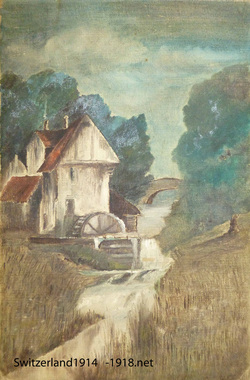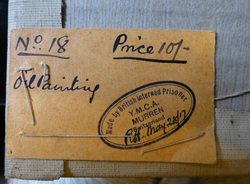
James bought the painting at auction about five years ago, and little is known about its prior history. However it does have some writting and a paper label on the back, stating that it was painted by Private A. Price (or Prise?) who was interned at Mürren, Switzerland.

Mürren was one of a number of camps in Switzerland that held British former prisoners of war who were interned for the rest of the war. In order to qualify for internment in Switzerland, they would have had a serious injury or other medical condition (find out more here). The village of Mürren was high up in the mountains (at 1,650m above sea level). Even in 2012, incidentally, access to Mürren is by cable car rather than road! The British internees here totalled 600 men and 30-40 officers. Although the internees were no longer prisoners of war, that did not mean that they had an easy or comfortable life.
A report by British member of parliament W.E. Hume-Williams dated 7 October 1916 describes how internees were beginning to recover from the hardships of PoW life: "The officers all live in the same hotel. The soldiers are mostly in hotels within a few yards, and the whole colony is in a small space and under easy control... The men are excellently fed and are so rapidly recovering under the influence of good food and good air that they already play football." He also reported that the Swiss commandant of the camp (a Captain Llopart) held regular roll calls and enforced regulations, with imprisonment being a possible punishment for offenders.
In May 1917 (the same month that this painting was made), the British clergyman Reverend R. Bulstrode was sent to Switzerland to help care for internees. After his visit to Mürren he called the camp "a prison in paradise". Despite the stunning mountain views, many internees were suffering from boredom and the long term psychological effects of years spent as prisoners of the Germans. Many were confined to their billets by either their wounds or illness, or the snow. He described how the YMCA had put up a hut where lectures and debates were held as a form of mental stimulation for the internees. This hut was presumably financed in part by the sale of paintings such as the one shown above.
Bulstrode also mentioned that while he was in Switzerland, he met Major A.J. Evans (later author of the book "The Escaping Club") and Lieutenant Buckley, who had just escaped to Switzerland from a German prisoner of war camp. Evans had both a brother and a sister at Mürren. His sister was a masseuse, and helped men recover the use of their limbs due to wounds.
Another British report (probably dating from late 1917) stated that "Mürren is built on a ledge. It takes five minutes to walk from one end of the place to the other. During seven months of the winter no roads are passable." The report described how 170 men were undertaking educational classes in shorthand or motor vehicle maintenance for example, and there was also an orchestra.
Mürren trivia fact: Part of the James Bond film "On Her Majesty's Secret Service" was shot nearby!
Sources:
Painting courtesy of James Gordon-Cumming Collection, www.trenchart.co.uk.
Reverend R. Bulstrode papers, Imperial War Museum Department of Documents, 87/10/1.
Reports on Swiss camps, , Imperial War Museum Department of Documents, Misc 26(473).
 RSS Feed
RSS Feed
